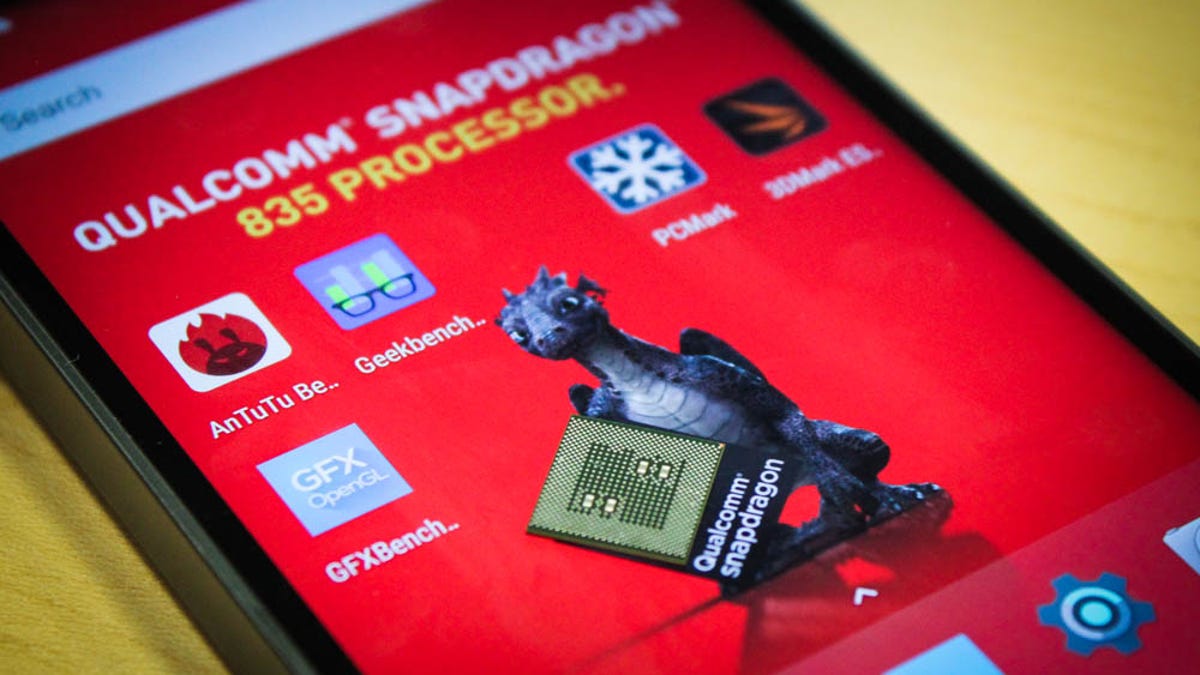This is how fast the Samsung Galaxy S8 could be
We benchmarked the Qualcomm Snapdragon 835 chipset and it's pretty freakin' fast.

Earlier this January, American chipmaker Qualcomm announced its latest Snapdragon 835 chipset, which is expected to power many upcoming flagship phones this year. It's inside the Sony Xperia XZ Premium as well as ZTE's concept "Gigabit" phone. But most significantly, it's speculated to power the Samsung Galaxy S8.
To see how well the 835 performs, I ran three benchmark tests on a Qualcomm reference device, and took the average out of three trials. Benchmark apps run a gamut of tasks and workloads to measure the performance and speed of the central processing unit (CPU) and often the graphics processing unit (GPU). Each app uses its own tasks and calculations to spit out a main score, but the basic rule is this: The higher the score, the better the device.
According to Qualcomm, the new chip takes up 35 percent less space and consumes 25 percent less power than its predecessor, the Snapdragon 820. As such, I compared the 835 to two premium 821 phones (which is a half-step more advanced than the 820): the Google Pixel XL and the OnePlus 3T. (I added the Apple iPhone 7 Plus too, though it's equipped with a proprietary 64-bit, A10 processor).
Antutu v6.2.7
Antutu results on the 835.
AnTuTu is one of the most popular benchmark apps and it keeps a running list of the top devices. Its central score is the sum of four separate scores. This includes a score for 3D graphics and games, user experience, CPU performance (like how well apps handle multitasking) and RAM.
The 835 reference device beat the 821 phones comfortably with its score of 182,535. While we couldn't get the benchmark to run consistently on our iPhone 7 Plus, the phone currently ranked number one on Antutu's list with a score of 181,807. The 835 barely edges out the 7 Plus in this regard, and given this info, we anticipate the upcoming 8 Plus to beat out the 835 in this benchmark as well.
Antutu v6.2.7 Benchmark
Geekbench v4.0
Geekbench results on the 835.
Geekbench is one of those great and consistent cross-platform benchmarks that runs on Mac, Windows, Linux, Android, iOS and even BlackBerry. It runs two workloads (single-core and multi-core), which are broken down into four more categories (cryptography, integer, floating and memory). Together they run all sorts of tests like how well a device can compress JPEGs, compute driving directions, render a PDF document, apply an image filter on a photo, recognize voice and speech, and deal with memory copy and latency.
Again, the 835 surpassed the Pixel XL and 3T easily. It also outpaced the 7 Plus in the multi-core test. On the single-core score, however, the 7 Plus was the winner.
Geekbench v4.0 Benchmark
- Geekbench single-core
- Geekbench multi-core
3DMark Ice Storm Unlimited
3DMark results on the 835.
3DMark is useful for measuring how fast the GPU can render 3D graphics in real time. We're particularly fond of the Ice Storm Unlimited test because it's for low-cost, basic mobile devices (which means we can test both low- and high-end phones and tablets). "Old" phones can run it too (think Android 4.0 and higher, and iOS 6 and higher). It includes two graphics test, fixed at a 720-pixel resolution, and another test to stress the CPU (a physics-based test). For more info, check out our 3DMark explainer.
For 3DMark, the 835 beat all these devices, which is a positive sign. As VR and VR headsets gain more popularity and prominence, how well your next phone handles graphics is going to be a significant feature.
3DMark Ice Storm Unlimited Benchmark
As expected, the 835 processor is superior to the 821, but take these benchmarks with a large pinch of salt. Your next phone may have the 835, but it may not garner the same results. Reference devices are designed for peak performance -- they don't run any bloatware, for example, and they're bigger. This means their insides run cooler, which helps efficiency. And just because the 835 has many new features, it's up to the phone manufacturer whether or not to use them all.
With that in mind, benchmarks can offer a slither of information about how well a device performs. So consider the results above just a small glimpse of how fast the upcoming Galaxy S8 (if it indeed ends up with the 835 inside) can be.
Editors' note: Tune in to watch the Galaxy S8 announcement live with CNET on March 29, starting at 7:30 a.m. PT/10:30 a.m. ET.

